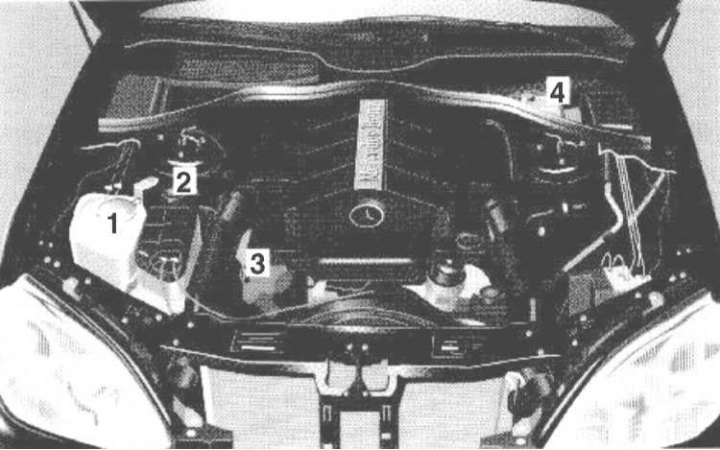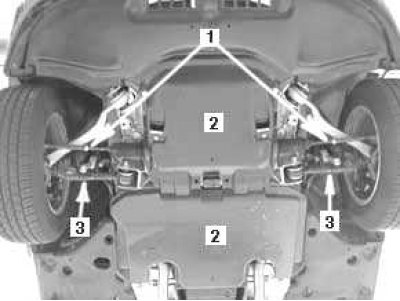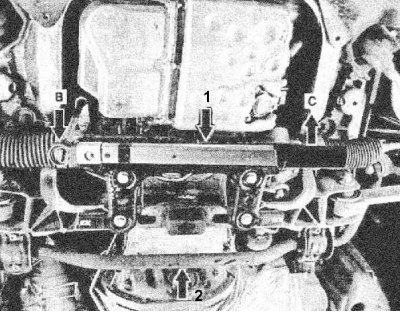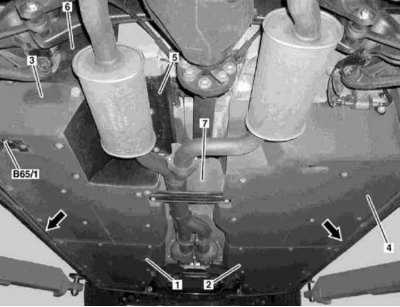Engine compartment. Models S600

1 - Reservoir for glass and headlight washers; 2 - Expansion tank; 3 - Dipstick for measuring the level of impellent oil; 4 - Brake fluid reservoir
View from the bottom. Front end. Crankcase protection 2 installed

1 - Tie rods; 2 - Crankcase protection; 3 - Lower arms
View from the bottom. Front end. Crankcase protection removed

1 - Rack and pinion steering mechanism; 2 - Bar stabilizer bar; B, C - directions of turning the key when tightening the hydraulic lines of the steering damper
View from the bottom. Rear end

1 - Left front shield; 2 - Right front shield; 3 - Right rear shield; 4 - Left rear shield; 5 - Silencer shield; 6 - Shield of the brake and fuel lines; 7 - Shield of the transmission line; B65/1 - Lower vehicle temperature sensor; 2 - Pre-silencer

Engine compartment. 1999 S500 Models

Engine compartment. 2000 S500 Models
The suggested recommendations assume that the vehicle owner performs the maintenance procedures himself, as opposed to the work performed at the service station of the DAIMLER-BENZ representative office. While this schedule is based on manufacturer's recommendations, intervals between most procedures can be shortened at the discretion of the vehicle owner, such as checking and changing lubricants and fluids at intervals that maximize engine or drive life. In addition, if the owner of the car is interested in keeping it in a state of maximum readiness for use in case of a possible resale, many procedures can be performed more frequently. We only welcome such an initiative.
The initial service and inspection of a new car must be carried out at a service station of the representative branch of the company in order to fulfill the conditions of the warranty obligation. This verification is free of charge.
Engine oil change and related work (every 9000 km or once a year)
Change the engine oil and oil filter, correct the oil level, check the levels of working fluids in the reservoirs of the engine compartment.
List A: The procedure is performed if the mileage since the last service according to list B is less than 22,000 km.
List B: The procedure is carried out if the mileage since the last service according to list B is more than 22,000 km.
Primary maintenance is carried out according to the list B.
(IN) brake system
Check up serviceability of functioning of a parking brake and reliability of deduction of the car by it on a slope.
Vehicle interior
(A and B) Check the correct operation of the following devices:
- TeleAid call systems;
- Sound and light signals, alarms and direction indicators;
- Control lamps, lighting and interior lighting;
- Outdoor lighting fixtures;
- Windscreen wipers;
- windshield washers (including headlight washers);
(A and B) Check the serviceability and condition of the seat belts.
(A and B) Reset the scheduled maintenance interval counter (FSS) on the instrument panel.
(IN) Replace the air cleaning filter of the heating and ventilation system
Wheels and brakes
(A) Adjust tire inflation pressure.
(B) Remove the wheels and check the remaining thickness of the friction linings of the brake pads.
(IN) Assess the condition of the brake discs.
(B) Change/rotate wheels (all four wheels must be the same size).
(B) Check the condition of the tires and measure the remaining tread depth.
(IN) car bottom
Check the elements located under the bottom for leaks.
Check the condition and proper routing of the hydraulic and fuel lines.
Check the condition of ball joints and silent blocks.
Assess the degree of wear of the steering gear components (backlash).
Engine compartment
(IN) Check the elements located in the engine compartment for signs of leaks.
(IN) Check the condition and proper routing of the hydraulic and fuel lines.
(A and B) Change the engine oil and oil filter.
Check the levels of all fluids:
- (A and B) Cooling systems;
- (A and B) brake system;
- (A and B) windshield washers;
- (IN) Power steering systems.
- (IN) clearance adjustment;
- (IN) Check the condition of the drive belts;
- (IN) Replace dust filter (without carbon element).
- (A and B) Check the operation of the hood latch.
(IN) Body
Check the correct adjustment of the optical axes of the headlights, if necessary, make the appropriate adjustment.
Replace windshield wiper blades (including headlight cleaners).
Luggage compartment
(IN) Check the electrolyte level in the battery.
(A) Check the inflation pressure of the spare tire.
Every 2 years
Change brake fluid. Check the condition of the paintwork, chassis components, load-bearing and supporting body elements.
Every 3 years
Replace coolant. Clean and lubricate the guide troughs and sliders of the sunroof cover. Replace the TeleAid emergency call system extra battery.
Every 5 years or 96,000 km
Replace spark plugs (Engine 137).
Every 5 years or 160,000 km
Replace spark plugs (Engines 112, 113).
Every 80,000 km (4 years)
Check the condition of the flexible couplings of the cardan shaft.
Every 96,000 km (4 years)
Check fuel filler seal, replace if damaged. Replace fuel filter, engine air filter element.
Every 96,000 km (5 years)
Replace the charcoal cabin air filter.
Engine compartment hood

Handle 1 for opening the hood of the engine compartment
There is a risk of injury!
There is a risk of injury if the hood is open and the engine is running.
After the engine is turned off, the radiator fan blades may rotate for approximately 30 seconds.
The engine is equipped with an electronic ignition system. Due to the high voltage of the ignition system, it is very dangerous to touch the elements of the ignition system (ignition coil, ignition distributor, high voltage wire, spark plug tips, test connector):
- with the engine running,
- when starting the engine,
- when the electronic key in the ignition switch is in position 2 and when turning the engine by hand.
Opening
Pull the lever in the direction of the arrow - the hood is released.
There is a danger of an accident!
Do not operate the lock lever while driving. Otherwise, the hood may open.
Engine compartment

Make sure that the wiper arms are not in the tilted position.
Closing

Close the hood. At the same time, hold your hands only on the edges -3-
If the hood does not lock, open it again and slam it shut with more force.
